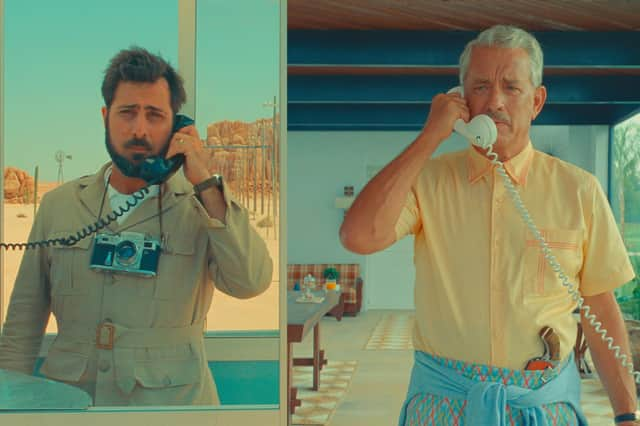Film reviews: Asteroid City | Stars at Noon


Asteroid City (12A) *****
Stars at Noon (15) **
It’s almost a cliché at this point to refer to Wes Anderson’s films as “insular”. He’s been creating cloistered worlds for his characters since his breakthrough film Rushmore and the ever-evolving complexity of those worlds is reflected in the fastidiousness with which he presents them: the diorama-like set designs, the deadpan formality of the dialogue, the precise way he moves his camera and the increasingly elaborate framing devices he uses to nest different narrative layers within each film have all resulted in a singular body of work that no one else could possibly have made. With his brilliant new film Asteroid City, though, Anderson takes that insularity to a playful new level with an ingenious riff on 1950s sci-fi films, one replete with alien encounters, Cold War paranoia, atom bomb testing and an all-star cast that includes Tom Hanks, Scarlett Johansson, Steve Carrell and Anderson regulars Jason Schwartzman, Tilda Swinton, Edward Norton, Jeffrey Wright, Bryan Cranston and Adrian Brody.
The film is set in tiny desert outpost built around a crater formed when a meteorite crashed there some 5,000 years earlier. Its name reveals plenty about its status as a failed tourist venture, something also reflected in its abandoned infrastructure and the fact that visitors can buy plots of land via a vending machine. In truth, though, the only visitors it really gets now are the delegates (and their families) of an annual stargazing convention for teenage science prodigies, the 1955 edition of which is about to start as the film opens.
Advertisement
Hide AdAmong the arrivals is an Elizabeth Taylor-esque movie star called Midge Campbell (Johansson) and a war photographer called Augie Steenbeck (Schwartzman). Both are accompanying their respective brainiac children, both are running away from deep-rooted pain that neither feel like talking about, and both, inevitably, find themselves gravitating towards each other when a government-mandated lockdown forces everyone to remain in Asteroid City following a mysterious extra-terrestrial event
Although Anderson has some fun playing around with the iconography of 1950s Americana and using his desert locale to pay sly homage to the old Looney Tunes Road Runner cartoons while also spoofing the conspiracy theory culture of the red-baiting Eisenhower era, the film isn’t a straight pastiche of an alien invasion B-movie. A sophisticated framing device presents Asteroid City as the finished play of a tortured Tennessee Williams-esque writer (played by Norton), whose creation of said play forms the backstage drama being documented in a black-and-white television broadcast promising viewers a complete view of the creation of a new artistic endeavour. These different levels of reality – distinguished by different aspect ratios, different colour schemes and different characters – allow Anderson to crack open Asteroid City’s main players in intriguing ways, particularly Schwartzman’s Augie, who experiences a fourth-wall-breaking existential crisis that sends him on a quest for meaning that takes him backstage in the process of his own creation.
It’s dizzying stuff and you can wrap your brain in knots trying to unpick it all. But as it’s playing it has the clarity of a dream, one bolstered by wonderfully droll turns from Anderson newcomers Johansson and Hanks (the latter playing Augie’s disapproving father-in-law), a subtly brilliant and moving performance from Schwartzman, and a couple of remarkable scenes amid the more typical Anderson set-pieces – one involves a theatre workshop, the other a scene we’re told has had to be cut from the play – that transcend anything he’s done before. The end result is a film that’s out of this world, not just Anderson’s.


Claire Denis makes sensual cinema, but her films are often better when grounded in the messy, everyday complexities of grown-ups falling in or out of love. When she flirts with genre, the results are mixed at best, tedious at worst. Sadly, Stars at Noon (like her 2018 sci-fi misfire High Life) falls into the latter category.
Broadly resembling a politically charged romantic thriller, it transposes Denis Johnson’s 1986 source novel about lovers on the run in 1980s Nicaragua to a sketchily rendered vision of the country in the age of Covid. Once Upon a Time... in Hollywood’s Margaret Qualley takes the lead as Trish, a young American woman who’s in dire straits having made a slapdash attempt to launch a journalism career by arriving in country with a dubiously acquired press card, no experience and no idea how to do the job. (John C Reilly makes a quick Zoom cameo as an exasperated editor determined to disavow her of her journalistic fantasies).
Forced to prostitute herself for money and favours, she has, however, acquired some street smarts in the time she’s been stranded there and when she meets Daniel (Joe Alwyn), a not-as-suave-as-he-seems Englishman who wears a linen suit well and claims to work for an oil company, she exposes his own naivety by pointing out to him that the people he’s meeting with are really working for the intelligence services.
Advertisement
Hide AdThough there’s something intriguing about this pair of pretenders bonding over a shared realisation they’re out of their depth in a country they don’t really understand, the lack of chemistry between Qualley and Alywn (who replaced Robert Pattinson after he dropped out) becomes all too evident as their relationship supposedly heats up. Consequently, the drama becomes more languid and the story more opaque, with Denis’ disdain for thriller conventions meaning she avoids the usual clichés but neglects to replace them with anything more interesting. Bennie Safdie briefly enlivens proceedings as a CIA agent on Trish and Daniel's trail.
Asteroid City is in cinemas from 23 June; Stars at Noon is available on digital demand now.